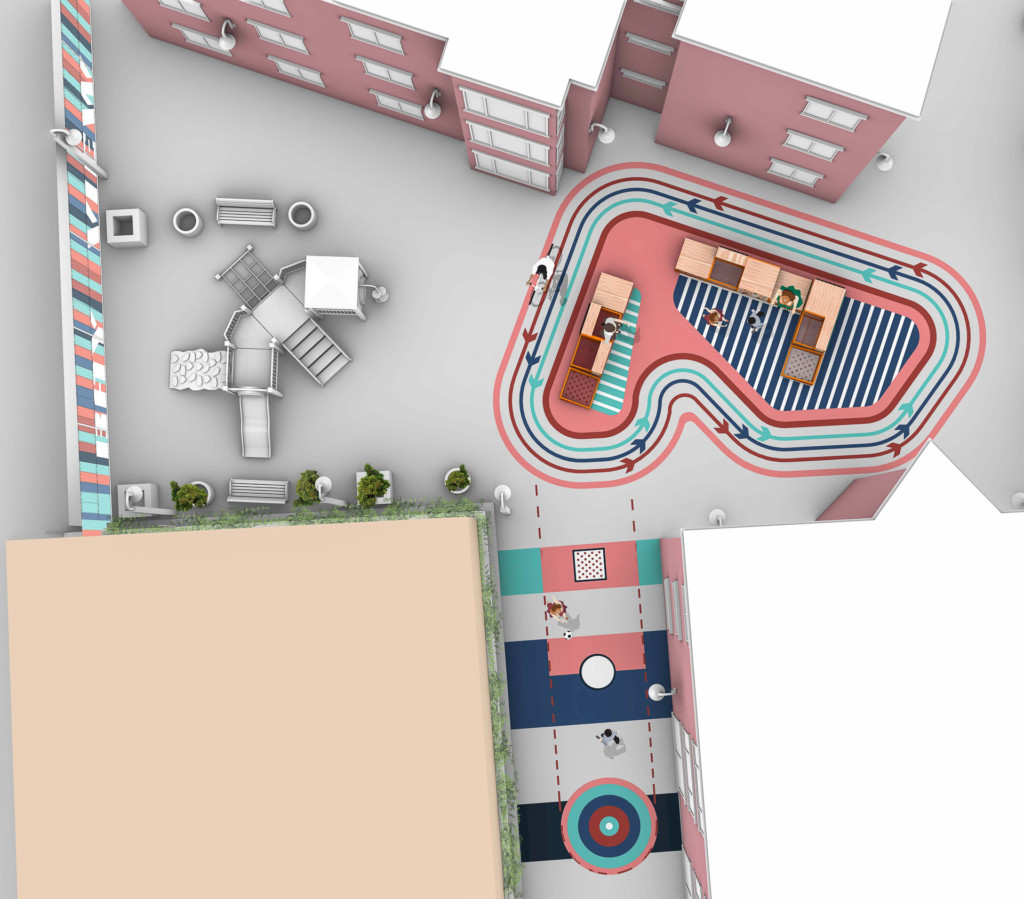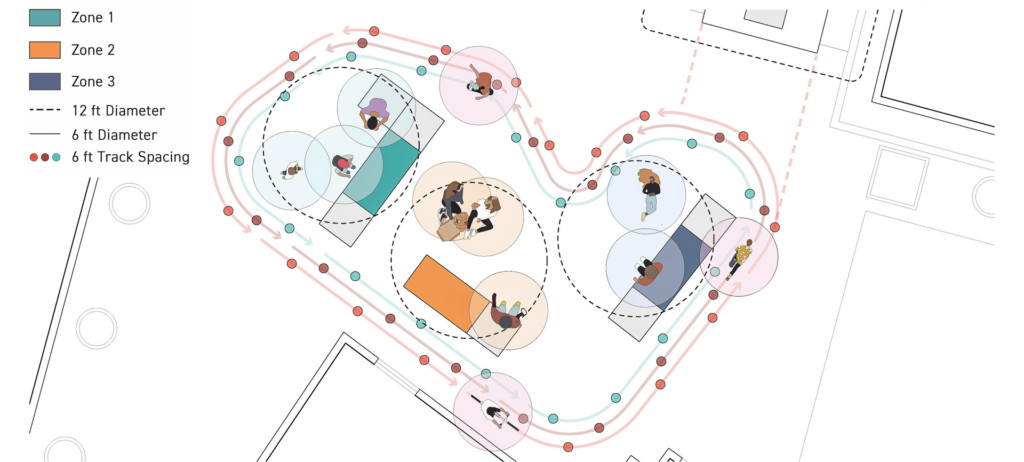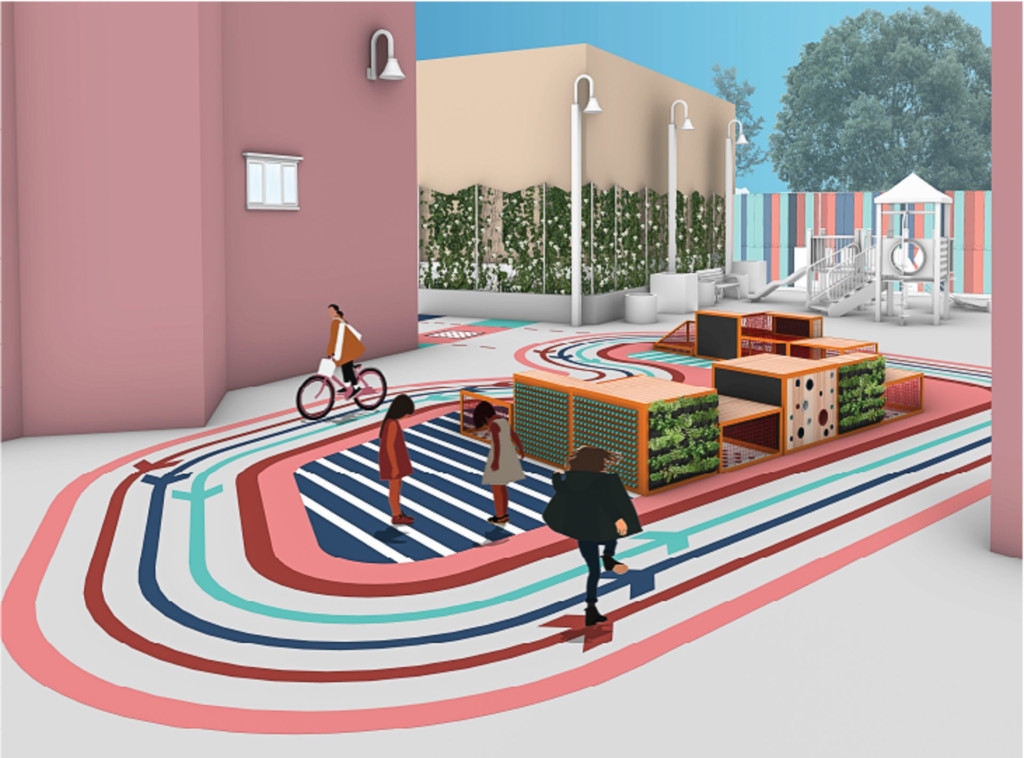By Greta Chiocchetti
Fifth-year students of the School of Architecture’s (ARH) community-based design program, B.Lab, took on their latest project at the beginning of the semester: a collaboration with the San Francisco Housing Development Corporation (SFHDC) and one of its affordable housing complexes, the Bayview Commons, located in the Bayview-Hunters Point neighborhood of San Francisco. Like all good designers, they knew their plan had to address their client’s many needs with style.
What they didn’t expect was that the 29 children who live in the apartment complex would become the driving force behind their design.
In what is B.Lab’s third collaboration with the SFHDC, a relationship created through ARH Executive Director Mimi Sullivan’s long-standing professional relationship with the nonprofit, students designed a furniture installation to fill an existing but underutilized courtyard. Through a series of meetings with residents of the complex’s 30 units, students asked what was most important to those living there. Overwhelmingly, residents responded that they wanted to craft a space for the building’s youth.

“It was important for us to have respect for the children’s visions,” said Adam Nuru, a student in the B.Lab class. “A lot of people kind of just think they know what kids want, and then they design without their input. But actually trying to get to know them one-on-one and figuring out what it was that they wanted—that was pretty cool. And now I feel like since we were able to understand kids that were like five years old and 10 years old, we’re going to be able to understand adult clients better, too.”
In order to maximize the installation’s potential, B.Lab students designed “Kid of Parts,” a series of flexible, modular pieces that could be used as seating, play structures, and even a vertical herb garden. Constructed mostly from steel, nylon rope, PVC, and cedar planks, the furniture will be fabricated entirely by the students. Using the same hues of an existing, vibrant mural (which was done by B.Lab students in 2018) students also included a track, color-coded to guide residents through the space, incorporating social distancing concerns for this unprecedented time in history.
B.Lab students organized workshops with the children of the Bayview Commons, hoping to introduce them to design and gain insight into how they interact with and interpret space. Although COVID-19 forced students and residents alike to shelter-in-place, halting the in-person meetings, the B.Lab team seamlessly made the transition to a virtual design office and conducted meetings with their clients through Zoom. Despite the challenges of keeping children in front of screens engaged, the platform offered the students a more intimate setting to get to know their clients.
“I think this was all new to a lot of the families and the kids—having a computer in the house and having online distance learning, and then dealing with us online and between everyone’s schedules and trying to track them down,” said Studio Faculty and B.Lab Coordinator Sameena Sitabkhan. “We were sitting there one-on-one and we’re like, ‘Hey,’ the kids are bouncing offscreen [and] back in. And so that was really fun for everyone to try and keep their attention and show them activities, and tell jokes, and ask them questions. But we probably got to know them a little bit more than we might have through just a traditional community meeting.”
With the school closing practically overnight, B.Lab students also lost access to their workshop, posing a challenge in the model-making phase of their planning. Paired with the fact that many art supplies were difficult to come by, students had to get crafty, using household objects instead.

“For the models, we recycled material, like our t-shirts,” said B.Lab student Corona Xiaohuan Gao, who also worked on the Unity Pavilion project the semester before. “I think it was [a success].”
The students were determined to create a space that showcased the best of their Academy education—creating a polished, yet whimsical design that the community could be proud of.
“I believe kids deserve good design. It should be for both the youth and adults—there doesn’t have to be a disconnect between the two,” said two-time B.Lab student Dylan Ingle. “That’s why we wanted to do elegant designs that also encourage intergenerational play at the same time.”
B.Lab, which is offered as an alternate thesis course to B.Arch students before they graduate with their professional degrees, is focused on cultivating and fostering diversity, equity, and advocacy for future public projects. As students’ semesters were radically shifted this spring, remembering the public good that would come from their hard work kept students pushing through the uncertainty of this time.

“Taking the knowledge and skills that I’ve learned from school and then being able to build it into the community, kind of sharing with the community—that’s what pushed me forward and kept me motivated,” said B.Lab student Markish Siojo.
B.Lab has already built an outdoor space for the residents of the Bayview-Hunters Point neighborhood—last semester, they installed an outdoor gathering space in the Northridge CommUNITY Garden, fondly referred to as the Unity Pavilion. Taking advantage of the abundance of fresh produce that grows there, including zucchini, eggplant, and kale, B.Lab students designed and built a gorgeous pavilion entirely out of redwood, designed as a gathering space for cooking demonstrations as well as a place for hosting community events.
“In a way, for us, this was good because we had both sides of the project,” said Fabio Lemos, who took the B.Lab class for a second time this spring. “Last semester we did all the building with the Unity Pavilion, and this semester it was much more design.”
Though the building process has been delayed due to COVID-19, B.Lab plans to make the courtyard a reality by the end of 2020. To help bring the community a vibrant new gathering space, support B.Lab’s IndieGogo campaign here: https://www.indiegogo.com/projects/kid-of-parts#/
